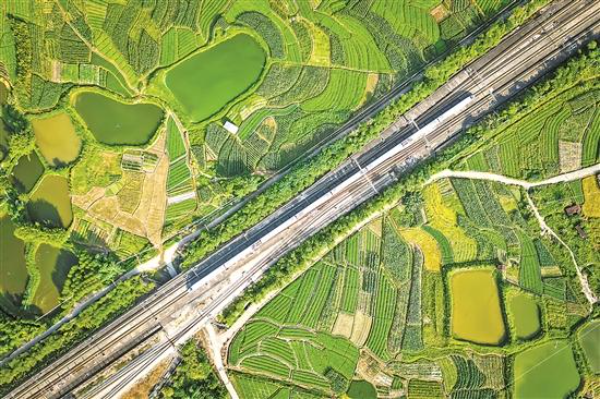On June 15th, the Wuhan-Guangzhou High-Speed Railway (Wuhan-Guangzhou HSR) began operating under a new train schedule, enabling the Beijing-Guangzhou High-Speed Railway (Beijing-Guangzhou HSR) to run at a standard speed of 350 km/h along its entire length. This upgrade will significantly reduce travel time between northern and southern China.

Fifteen years ago, the Wuhan-Guangzhou HSR, which forms the southern section of the Beijing-Guangzhou HSR and was the world's longest high-speed railway at the time, officially opened. Since then, the route has been a focal point for the provinces and cities along its route. Starting from June 15th, the key north-south corridor will regularly operate at the high standard speed of 350 km/h, tightening the connections between the central regions and the Guangdong-Hong Kong-Macao Greater Bay Area. The enhanced speed promises more vibrant exchanges and economic interactions.

As one of the busiest passenger routes in the country, the Wuhan-Guangzhou HSR has transported approximately 1.685 billion passengers from its opening on December 26th, 2009, to May 31st, 2024. This number equates to each resident of Guangdong, Hunan, and Hubei provinces having traveled on the high-speed train more than six times.
At 9:50 AM on June 15th, train G814 departed from Guangzhou South Railway Station and arrived at Changsha South Railway Station 1 hour and 59 minutes later. "This is one of the fastest trips from Guangzhou to Changsha after the high-speed operation started," said Xiao Hongyu, the driver of G814.
The creation of a "two-hour economic and living circle" between Guangdong and Hunan and the acceleration of the central region's integration with the Greater Bay Area are significant achievements of the Wuhan-Guangzhou HSR over the past 15 years. This extensive land and sea connectivity, facilitating north-south interactions, is gradually unfolding across this vast region.
As China's first major long-distance high-speed railway, the Wuhan-Guangzhou HSR has served as a rapid, high-capacity "golden corridor" since its opening in 2009. It has quickly expanded the economic and living reach of the Pearl River Delta, the Changsha-Zhuzhou-Xiangtan city cluster, and the Wuhan metropolitan area. Cities along the high-speed rail lines in northern Guangdong, Hunan, and Hubei have continuously attracted investment, collectively hosting over 15,000 industrial transfer projects from the Pearl River Delta, with total investments exceeding one trillion yuan. High-speed rail new towns, high-speed rail new areas, and industrial parks have sprung up like mushrooms after rain, creating a massive industrial economic belt along the Wuhan-Guangzhou HSR corridor.

Since the opening of Guangzhou South Railway Station on the Wuhan-Guangzhou HSR, the station has handled a cumulative 1.48 billion passenger arrivals and departures, establishing its reputation as a "super hub." The movement of people has driven economic activity, turning the surrounding area into a dynamic new urban center. Covering approximately 310 square kilometers and spanning both Guangzhou and Foshan, this new city hub has evolved from a simple transportation node to a comprehensive service center for the Guangdong-Hong Kong-Macao Greater Bay Area, becoming one of Guangzhou's new landmarks.
Shaoguan, known as the "city connecting the north and south," has developed a unique high-speed rail new town centered around its HSR station. This new town, with a planned area of about 20 square kilometers and a population capacity of around 300,000, is set to become Shaoguan's future administrative, transportation, tourism, and financial center within the next few years.
In Hunan, the Wuhan-Guangzhou HSR has spurred the formation of a new urban area around Changsha South Railway Station, known as Wuguang New City. This area has rapidly developed high-quality commercial, financial, consulting, and exhibition services. Lituo Town, where Changsha South Railway Station is located, has grown from a small town of over 50,000 residents to an industrial hub with a population of 500,000. Changsha aims to develop this area into its version of Shanghai's Pudong. Recent GDP rankings of cities in Hunan show that five of the top six cities are located along the Wuhan-Guangzhou HSR line, highlighting the railway's significant economic impact.
All materials marked with "source: English.gz.gov.cn" on this website (including but not limited to text, photographs, audio and video materials) are the copyrighted property of Guangzhou International (the official website of Guangzhou Municipality). Without prior authorization from Guangzhou International, any media, website, organization or individual shall not transmit, interlink, distribute or republish such materials in any form. Any media and website authorized to republish such materials shall mark them with "source: Guangzhou International (English.gz.gov.cn)". Infringement of these copyrights will result in legal action.
